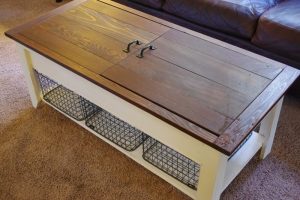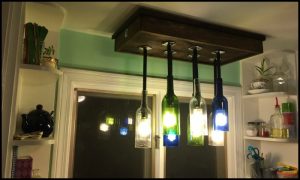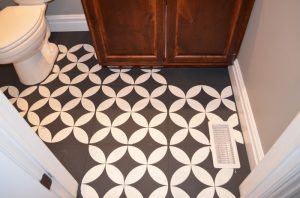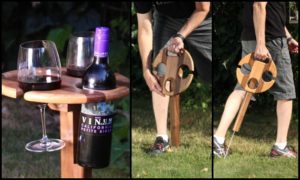Last Updated on January 24, 2025 by teamobn
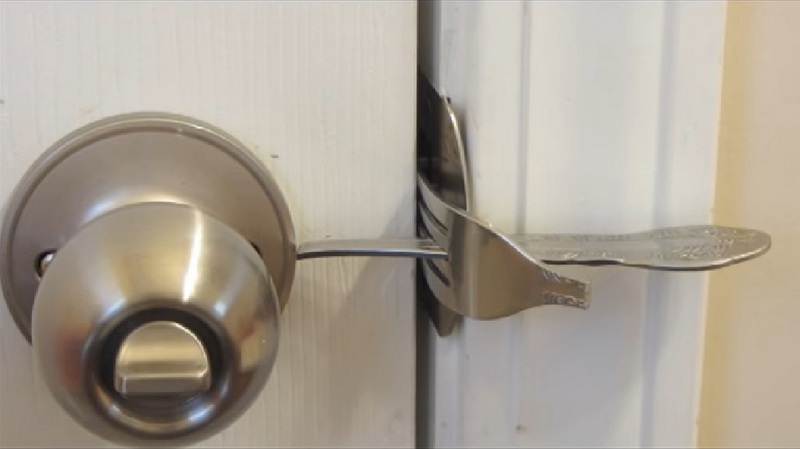
Home security is important for everyone, but it’s especially important for those who have experienced a burglary. Just when you think your home is safe, another one can happen. That’s why it’s important to take some simple precautions and be aware of your surroundings.
There are 2.5 million break-ins in the US alone. In fact, break-ins occur in that country every 13 seconds. Some 66% of these involve home break-ins. This is a serious problem that needs to be addressed. There are many ways to avoid break-ins, such as investing in a home security system, being vigilant about locking doors and windows, and keeping valuables out of sight. Burglaries are costly not only in terms of the property that is stolen but also in terms of the emotional toll they take on victims. It is important to do everything possible to avoid them.
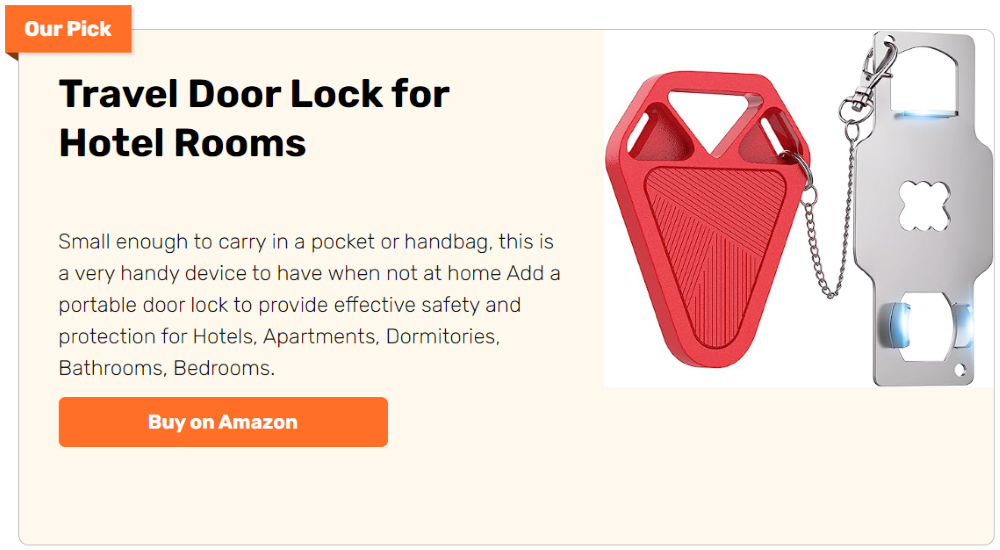
It is always better to be safe than sorry. If you can install an additional door lock for added security, do it. Installing a home security system can be costly, but not installing one could cost you even more. Home security systems provide peace of mind and can ward off hazards.
However extra security does not always require a hefty investment. Sometimes, all you need is a little creativity and effort.
Consider a fork door lock. It’s inexpensive, easy to install, and works! However, you’ll have to choose your fork wisely to ensure its durability. The prongs should be between 1 ¾”-2” in length for them to work properly.
This DIY fork door lock project is a cheap and easy way to add an extra level of security to your home. For just a few dollars, you can purchase a fork and some other basic supplies to make this door lock. This project is how to secure a door easily and at a low cost.
Contents [show]
How to Secure a Door With a Fork Door Lock
Materials to create fork homemade door locks:
- Fork (that has prongs that are between an inch and 3/4 and 2 inches in length and choose a design with a tapered handle)
- Marker
Tools:
- Vise
- Hammer
- Hacksaw
Steps:
To install a fork door lock, begin by taking the fork and placing it in the latch hole. Then, use a permanent marker to draw a line down the centre of the prongs that are on the edge of the latch hole. This will show you the depth of the latch hole.
Put the fork in the vise, making sure that the prongs are pointing downwards and that you can see the line you marked earlier about a1/8 if an inch out. You may need to adjust the jaws of the vise to get a good grip on the fork. Next, take a hammer and bend the tines of your fork at a 90-degree angle. This will be the basis for your fork door lock project.
After making a 90-degree angle in the prongs of your fork, you will need to cut the handle of the fork using a hacksaw. You will still need to put the fork in a vise, but this time you will need to hold the handle in the vise to easily cut it from the neck of the fork. If necessary, you can use a saw blade guide to help you make a straight cut.
After you have cut the handle to the appropriate size, you can test the fit by sliding it into the slot on the prongs. If it is a tight fit, you can use a grinder or file to smooth out the edges. This will ensure a smooth, seamless fit.
How does this fork door lock work?
Take the prongs of the fork and insert them into the latch hole, and you can shut the door. You can insert the handle of the fork into the slots of the prongs, this will lock the door!
Click on any image to start the lightbox display. Use your Esc key to close the lightbox.

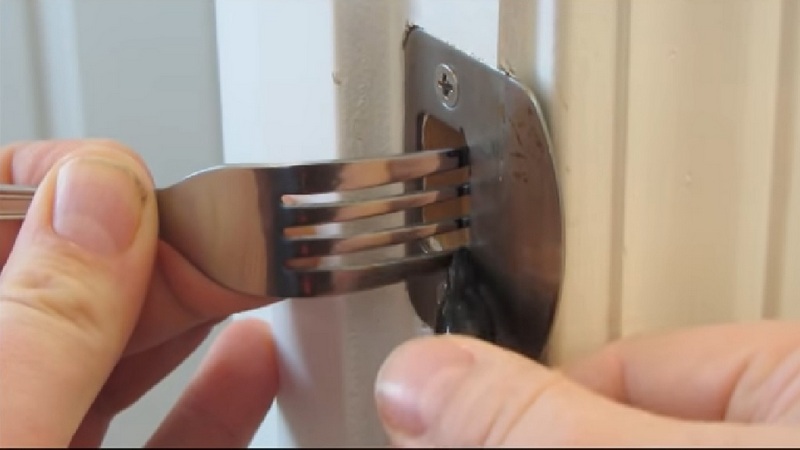

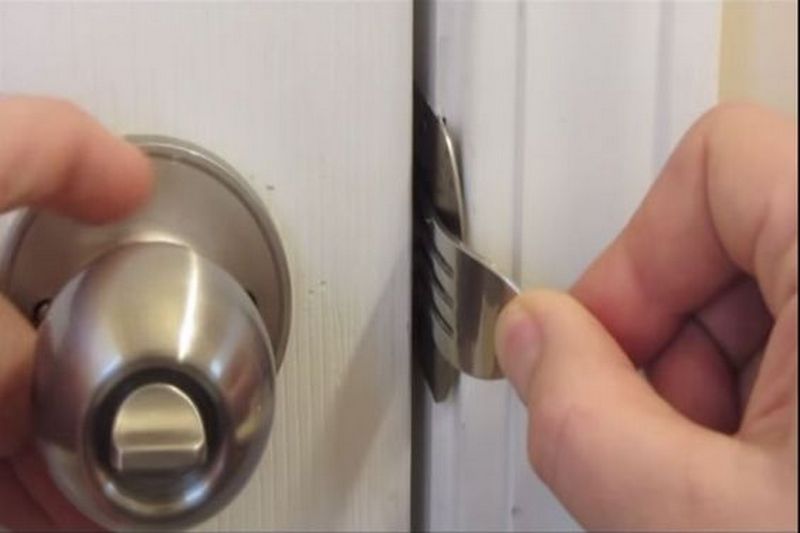
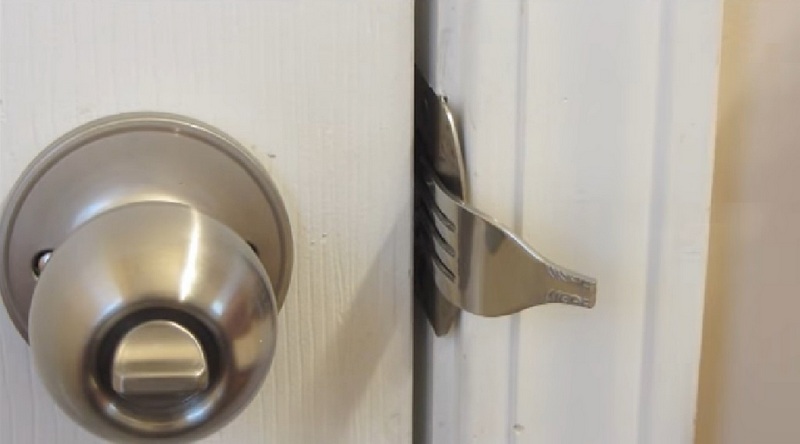

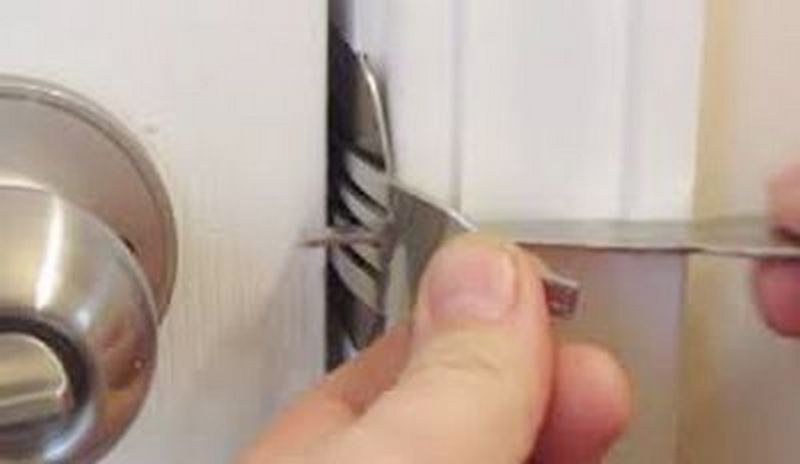


Thanks to Phil Crockett for this great project. You can get step-by-step instructions below…
Advantages of Fork Door Lock
- Cost-effectiveness: The primary advantage of a DIY fork door lock is its affordability. Forks are readily available household items, often found at no cost or for a minimal price. Compared to purchasing commercial door locks or security systems, making a fork door lock is significantly cheaper.
- Accessibility: DIY fork door locks are accessible to anyone, regardless of their DIY skills or resources. The materials required are simple and easy to find, making this security solution available to individuals with varying budgets and levels of expertise.
- Quick and Easy Installation: Installing a DIY fork door lock is a straightforward process that typically requires no specialized tools or technical knowledge. In most cases, it involves inserting forks into the door frame or jam, making it a quick and easy security enhancement for homeowners.
- Immediate Implementation: Unlike professional security installations, which may require scheduling appointments and waiting for technicians, a DIY fork door lock can be implemented immediately. This allows homeowners to enhance their security measures promptly without delays.
- Deterrent Effect: The presence of a visible security measure, such as a DIY fork door lock, can act as a deterrent to potential intruders. Even though it may not offer the same level of security as commercial locks or alarms, the sight of a makeshift security device may discourage burglars from attempting unauthorized entry.
- Customization: DIY fork door locks offer flexibility in terms of customization. Homeowners can adjust the number and arrangement of forks to suit their specific security needs and preferences. Additionally, they can paint or decorate the forks to blend in with the door’s aesthetics or make them more conspicuous as a deterrent.
- Temporary or Portable Solution: DIY fork door locks can serve as temporary security solutions in situations where permanent fixtures are not feasible or available. They can also be used as portable security devices for temporary accommodations, such as rental properties or vacation homes.
Overall, a DIY fork door lock offers a cost-effective, accessible, and customizable way to enhance home security. While it may not provide the same level of protection as commercial-grade security systems, it can be a practical and immediate solution for homeowners seeking additional security measures.
Safety Precautions When Building Your Fork Door Lock
Crafting and implementing a fork door lock demands prioritizing safety. Below is a detailed guide encompassing safety precautions for a fork door lock:
1. Handle Forks with Care:
Forks, even after modifications, might retain sharp edges or points. Handle them cautiously to avert accidental cuts or punctures. Wearing gloves can shield your hands from potential injuries during manipulation.
When manipulating modified forks during installation or adjustments, be mindful of your movements to avoid inadvertently coming into contact with sharp edges or points. Handle the forks with care to minimize the risk of injury. Stay vigilant to avoid unwanted accents.
2. Employ Proper Tools:
Utilize appropriate tools when altering the forks or affixing them to the door frame. Avoid excessive force or unsuitable tools, as these could result in accidents or damage to the forks or door frame.
3. Assure Stability:
Before entrusting the fork door lock with security responsibilities, confirm the forks are securely affixed to the door frame or jam. Test the lock’s stability by gently applying pressure to the door to ensure the forks remain intact and can resist external force.
Gently apply pressure to the door to simulate an attempt to force it open from the outside. Observe the forks closely to ensure they remain intact and do not dislodge or bend under pressure. This test helps assess the stability of the lock and its ability to resist external force.
4. Verify Door Functionality:
Post-installation of the fork door lock, verify that the door retains its functionality. Ensure it can open, close, and lock without any hindrance from the forks. Adjust the forks’ position or consider alternative placement if functionality is compromised.
Throughout this process, ensure that the forks remain securely attached to the door frame or jam. Check for any signs of loosening or instability that may compromise the effectiveness of the lock. Reinforce the attachment as needed to maintain security.
5. Prevent Exit Obstruction:
Refrain from obstructing doorways or emergency exits with the fork door lock. Guarantee the lock does not impede easy access to exits during emergencies. Always maintain clear pathways to facilitate safe evacuation.
Stay vigilant and maintain awareness of potential hazards associated with obstructing doorways or emergency exits. Encourage a culture of safety among household members or occupants and emphasize the importance of prioritizing evacuation in emergencies.
6. Educate Household Members:
If sharing living quarters, inform others about the presence and purpose of the fork door lock. Educate them on a safe and responsible operation to mitigate the risk of accidents or misuse.
Demonstrate the proper operation of the fork door lock to all occupants, illustrating how to engage and disengage it safely. Emphasize the importance of using the lock responsibly to prevent accidents or misuse that may compromise safety.
7. Routine Inspections:
Conduct periodic inspections of the fork door lock to ensure ongoing effectiveness and safety. Check for signs of damage, wear, or loosening of the forks, addressing any issues promptly to maintain security and prevent accidents.
Start by visually examining the fork door lock. Look for signs of damage, wear, or loosening of the forks. Inspect the attachment points to ensure they are secure and there are no visible defects. Inspect the forks themselves for any signs of damage or wear. Pay attention to the tines to ensure they are straight and undamaged. Bent or weakened forks can compromise the effectiveness of the lock.
8. Consider Alternatives:
While a fork door lock can augment security, explore alternative solutions such as upgrading to commercial-grade locks or installing a comprehensive security system. Assess security needs thoroughly to determine the most suitable solution for your premises.
By adhering to these safety precautions, crafting and utilizing a fork door lock can be both safe and effective. Always prioritize safety when implementing DIY security measures to safeguard yourself, your loved ones, and your property.
Best Security Options for Your Door
When it comes to safeguarding your front door, a variety of solutions are at your disposal, ranging from a complete door overhaul to simple enhancements like adding a security bar.
Understanding Security Doors
Unlike standard doors, security doors are designed with extra strength materials such as steel or aluminum to provide enhanced protection.
Reinforced Security Doors
These doors often include a sturdy core of steel enclosed by wood layers. This construction makes it significantly harder for intruders to break through. For those who prefer aesthetics, there are options that mimic traditional door styles, seamlessly blending with your home’s current appearance. Besides being ideal for the front entrance, these doors can also be installed throughout your home to secure specific rooms, like bedrooms.
Key features often include concealed hinges and strong hinge screws, making it difficult for burglars to remove the door from the outside.
Security Screen Doors
For a dual-layer defense, consider security screen doors. These not only protect your main door but also function as a secondary shield. Constructed with an aluminum frame and a tough mesh screen, they provide solid security. Alternatives may include wrought iron, vinyl, or even tempered glass options, each paired with an effective mesh screen.
Additional Security Measures
- Smart Locks: These offer keyless entry and can be controlled via smartphone, enhancing convenience and security.
- Doorbell Cameras: With real-time video and motion detection, these systems let you see who’s at your door, whether you’re home or away.
- Deadbolts: A high-quality deadbolt can add an extra layer of security to any door.
By customizing your security strategy with these elements, you can significantly improve the safety of your home while maintaining its curb appeal.
The Wrap Up
Making a DIY fork door lock offers an affordable and accessible means of enhancing home security. This ingenious solution utilizes common household items to provide an additional layer of protection against unauthorized entry. With its simplicity, cost-effectiveness, and customizable features, a fork door lock can serve as a practical option for those seeking to bolster security without breaking the bank.
However, it is essential to approach the implementation of a DIY fork door lock with caution and prioritize safety. Adhering to safety precautions, such as handling forks carefully, ensuring stability, and avoiding obstruction of exits, is paramount to prevent accidents and maintain effectiveness.
While a fork door lock may not provide the same level of security as commercial-grade locks or sophisticated security systems, it can serve as a visible deterrent to potential intruders and offer peace of mind to homeowners. Additionally, for temporary security needs or situations where a quick and inexpensive solution is required, a DIY fork door lock can be a practical choice.
However, it is crucial to approach the installation and use of a fork door lock with caution and prioritize safety. Adhering to safety precautions, such as handling forks carefully, ensuring stability, and avoiding obstruction of exits, is essential to prevent accidents and maintain effectiveness.
Whether used as a standalone security measure or in conjunction with other security systems, a DIY fork door lock demonstrates resourcefulness, creativity, and the willingness to take proactive steps to protect one’s home and loved ones. By embracing innovation and prioritizing safety, homeowners can harness the advantages of a DIY fork door lock as a cost-effective and efficient way to bolster their security defences.
The fork door lock represents a creative DIY solution that underscores resourcefulness and ingenuity. It demonstrates a proactive approach to home security and provides homeowners with added peace of mind.
Are you ready to make your fork door lock? Good luck!
FAQ: How to Secure a Door
- What is a fork door lock?
- A fork door lock is a simple yet ingenious DIY security solution crafted from everyday household items, primarily forks. These forks are repurposed to serve as makeshift barriers, adding an extra layer of security to doors within homes or other properties. By strategically placing forks in the door frame or jam, individuals can effectively deter unauthorized entry.
- How does a fork door lock work?
- A fork door lock uses the tines of forks to obstruct the door from opening. The forks are typically inserted horizontally into the door frame or jam, making a barrier that prevents the door from being pushed open from the outside.
- Like any security measure, a fork door lock requires regular maintenance and monitoring to ensure continued effectiveness. Periodically check the stability of the forks and make any necessary adjustments or repairs to maintain the integrity of the barrier.
- Is a fork door lock effective?
- While a fork door lock may not offer the same level of security as commercial-grade locks or advanced security systems, it can serve as a visible deterrent to potential intruders. Its effectiveness depends on factors such as the number and placement of forks used, as well as the overall security measures in place.
- How do you install a fork door lock?
- Installing a fork door lock is relatively simple and typically involves inserting forks into the door frame or jam at strategic locations to prevent the door from opening. However, it’s essential to ensure that the forks are securely fastened and do not interfere with the door’s operation.
- Are there any safety considerations when using a fork door lock?
- Yes, safety is paramount when using a fork door lock. It’s essential to handle forks with care to avoid injury, ensure that the forks are securely fastened to prevent accidents, and avoid obstructing exits in case of emergencies.
- Can you use a fork door lock on any type of door?
- Fork door locks are typically designed for use on standard interior doors. While they may provide some additional security for certain types of doors, such as bedroom or office doors, they may not be suitable for all door types or situations.
- Is a fork door lock legal?
- The legality of using a fork door lock may vary depending on local regulations and building codes. It’s essential to check with local authorities or consult a security professional to ensure compliance with applicable laws and regulations.
- Can you remove a fork door lock easily?
- Yes, fork door locks are typically easy to remove, as they are installed using common household items. However, it’s crucial to ensure that the forks are removed safely and that any damage to the door frame or jam is repaired afterwards.
- What are simple ways to make your door more secure?
- Enhancing your door security is a straightforward way to protect your home. Reinforce the strike plate with a stronger version and switch to interior hinges to prevent tampering. Install a wide-angle peephole for better visibility and upgrade to modern, high-security locks, including deadbolts, for added protection.
- Avoid common hiding spots for spare keys by using secure key safes or entrusting them to a trusted neighbor, and regularly inspect door hardware, replacing worn or rusted components to maintain durability. These steps collectively fortify your door and boost your home’s safety.
- How do you secure a door without locking it?
- Securing a door without locking it is possible with the right tools and techniques. A fork door lock is an innovative and portable option that uses a modified fork to create a strong temporary barrier by wedging into the door frame and handle. Door barricades and security bars offer physical resistance, while door jammers and portable locks provide quick and effective ways to block forced entry.
- Reinforcing the door and frame with sturdy materials like metal or hardwood and installing security cameras or motion-activated lights can act as strong deterrents. Combining these methods enhances your door’s security even without traditional locks.
- What is a door brace and how can is it an extra security door lock?
- A door brace is a security device designed to strengthen your door against forced entry. It acts as a physical barrier, preventing the door from being opened even if the lock is compromised, and is easy to install on most standard doors in just minutes.
- Door braces are an affordable and portable solution, ideal for renters or those seeking enhanced security without investing in a full security system. By reinforcing the door, they provide an effective and convenient way to add an extra layer of protection and peace of mind.
- Why do I need security bars if I already have good door locks?
- Security bars are a vital addition to your home, even if you have top-notch door locks. They provide enhanced protection by acting as a physical barrier, making forced entry significantly harder, even for skilled intruders.
- Security bars also serve as a visual deterrent, signaling a fortified entry that discourages burglars. Affordable and easy to install, they are particularly effective for sliding doors and offer a quick security upgrade, ensuring peace of mind and an extra layer of safety for your home.
These FAQs provide an overview of fork door locks and address common questions about their use, effectiveness, installation, safety considerations, legality, and removal.


